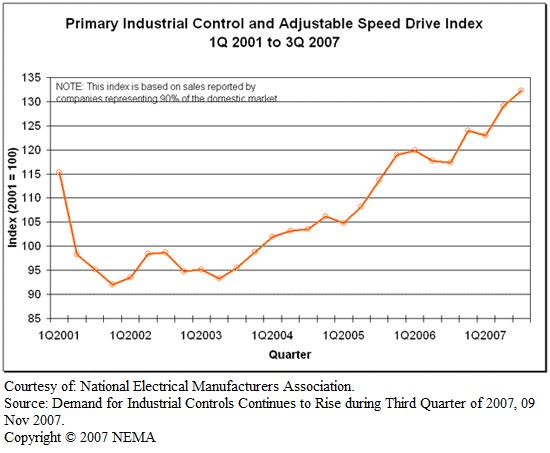According to the National Electrical Manufacturers Association (NEMA), industrial control shipments continued to grow throughout 2007. Although measures of confidence among manufacturers slipped in the second half of the year, indicators of the industrial sector’s performance remained in solid shape.
 Looking ahead, reports from the Manufacturers Alliance (MAPI) indicate that the combination of the credit crunch, housing slowdown and high oil prices will slow GDP growth to just 1.3 percent in 2008. According to a survey by the National Association of Manufacturers (NAM), large manufacturers expect their capital expenditures to rise by just 0.3%, while small companies expect their investment spending to grow by a stronger 1.6%. For both large and small firms, this is a significant slowdown. These trends are consistent with a slowdown in overall business investment spending that has taken place over the past year. The third quarter survey suggests that investment spending by manufacturers will continue to grow over the next year, but at a slower pace than during the past few years.
Looking ahead, reports from the Manufacturers Alliance (MAPI) indicate that the combination of the credit crunch, housing slowdown and high oil prices will slow GDP growth to just 1.3 percent in 2008. According to a survey by the National Association of Manufacturers (NAM), large manufacturers expect their capital expenditures to rise by just 0.3%, while small companies expect their investment spending to grow by a stronger 1.6%. For both large and small firms, this is a significant slowdown. These trends are consistent with a slowdown in overall business investment spending that has taken place over the past year. The third quarter survey suggests that investment spending by manufacturers will continue to grow over the next year, but at a slower pace than during the past few years.
Interestingly, exports appear to be a major factor in the 2008 economy, and could possibly comprise one-half of the U.S. gross domestic product increase next year. The weakening dollar coupled with continued global demand for U.S. industrial products, including high technology, military equipment and heavy machinery, will contribute to net export gains of over 8 percent in 2008.
Water, Water, Everywhere…
With 2007’s extreme drought in the Southeast and other regions of the country, one seemingly sensible solution to the scarcity of water is to take the salt out of seawater. Desalination refers to any of several processes that remove excess salt and other minerals from water to make it suitable for animal consumption or irrigation, or, if almost all of the salt is removed, for human consumption. Obvious as desalinated water might sound, the energy costs have slowed its widespread adoption.
Depending on local energy prices, 1,000 gallons of desalinated seawater can cost around $3 or $4. Although that might not seem like much, it is still cheaper in many places to pump water out of the ground or import it from somewhere else.
Distillation is perhaps the one water treatment technology that most completely reduces the widest range of drinking water contaminants. However, the energy required for the distillation process makes it prohibitively expensive on a large scale. Much of the current market for “thermal desalination” has therefore been in oil-rich, water-poor countries in the Middle East.
Since the 1950s, researchers have been developing membranes that could filter out salt. This membrane technique, sometimes called “reverse osmosis,” requires one-fourth of the energy and costs half the price of distilling saltwater. But even with membranes, large amounts of energy are needed to generate the high pressure that forces the water through the filter. Lowering the energy required and keeping membranes clean are two big challenges facing reverse-osmosis desalination. Recent research in the U.S. indicates that nanotube membranes may prove to be extremely effective for water filtration and may produce a viable water desalination process that would require substantially less energy than reverse osmosis.
Variations on desalination energy supplies include solar or wind-powered methods that could be useful in remote applications or in regions where those energy sources are consistent. In Perth, Australia, in 2007, a wind-powered desalination plant was opened that provides nearly 40 million gallons of clean water per day. As fresh water becomes scarcer in certain regions, even the current costs of desalination processes may well be worth the investment.
Originally Published: June 1, 2008

